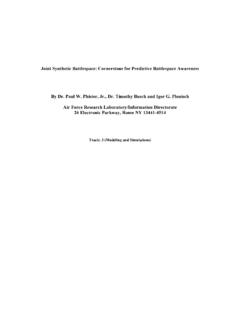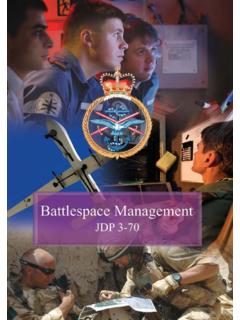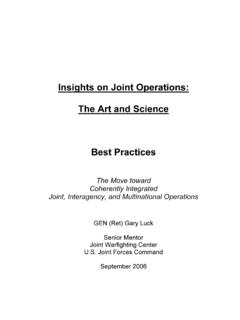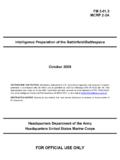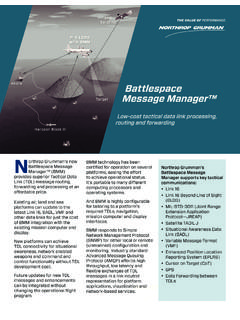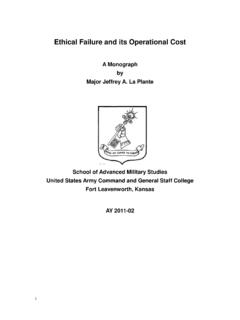Transcription of BY ORDER OF THE AIR FORCE HANDBOOK 31-115, …
1 BY ORDER OF THE AIR FORCE HANDBOOK 31-115, SECRETARY OF THE AIR FORCE VOLUME 1. 29 APRIL 2015. Certified Current 7 April 2016. Security SECURITY FORCES SUPPORT TO THREAT. INFORMATION INTEGRATION. COMPLIANCE WITH THIS PUBLICATION IS MANDATORY. ACCESSIBILITY: This publication is available for downloading or ordering on the e-Publishing website at RELEASABILITY: There are no restrictions on the release of this HANDBOOK . OPR: AF/A4SO Certified by: AF/A4S. (Brig Gen Allen J. Jamerson). Pages: 48. This Air FORCE HANDBOOK (AFH) complements and amplifies guidance in AFI 31-101, Integrated Defense, and contributes to the Security Forces' mission of securing Department of Defense (DoD) and Air FORCE assets. This publication outlines the role of the Security Forces liaison contributing to Threat Information Integration (TII). Actions outlined in this publication should be considered baseline measures for Security Forces Staff S-2 function personnel to perform during Integrated Defense (ID) operations within the Continental United States (CONUS).
2 These baseline measures can and should be expanded when operations are performed in Outside Continental United States (OCONUS) and expeditionary environments based on increased capabilities and/or restrictions. It provides baseline tactical-level guidance for Security Forces personnel contributing to TII. It identifies tasks Security Forces should be completing, and methods on how to complete them. Ensure that all records created as a result of processes prescribed in this publication are maintained in accordance with (IAW) Air FORCE Manual (AFMAN) 33-363, Management of Records, and disposed of IAW Air FORCE Records Disposition Schedule (RDS) located in the Air FORCE Records Information Management System (AFRIMS) located at Refer recommended changes and questions about this publication to the Office of Primary Responsibility (OPR). using AF Form 847, Recommendation for Change of Publication, and route AF Forms 847 from the field through the appropriate functional chain of command.
3 This publication may be supplemented at any level. The use of the name or mark of any specific manufacturer, commercial product, commodity, or service in this publication does not imply endorsement by the Air FORCE . 2 AFH31-115V1 29 APRIL 2015. Chapter 1 S2 ROLE IN INTEGRATED DEFENSE (ID) 3. Organization and Role.. 3. Training.. 4. Equipment.. 5. Chapter 2 THREAT INFORMATION INTEGRATION OVERVIEW 7. Information Sharing.. 7. Information Integration.. 10. Threat Information Integration.. 10. Chapter 3 OPERATIONAL PROCESSES 13. Scope of Effort.. 13. Data Integration Process.. 14. Figure Source Reliability/Information Validity Matrix.. 15. Ground Tasking ORDER Process.. 22. Figure Ground Tasking ORDER Process.. 23. Chapter 4 INTELLIGENCE PREPARATION OF THE battlespace 25. Introduction.. 25. Step 1 Define The battlespace Environment.. 25. Step 2 Describe The battlespace 's Effects.
4 27. Step 3 Evaluate The Threat.. 28. Step 4 Determine Threat COAs.. 31. Tips for Success.. 32. Attachment 1 GLOSSARY OF REFERENCES AND SUPPORTING INFORMATION 34. Attachment 2 REQUEST FOR INFORMATION (RFI) EXAMPLES 40. Attachment 3 PATTERN ANALYSIS EXAMPLE 41. Attachment 4 SITUATIONAL AWARNESS BULLETIN EXAMPLE 42. Attachment 5 STORYBOARD EXAMPLE 44. Attachment 6 GROUND TASKING ORDER EXAMPLE 45. Attachment 7 PATROL AFTER ACTION REPORT (PAAR) 46. Attachment 8 AREA OF INTEREST MAP 47. Attachment 9 MODIFIED COMBINED OBSTACLE OVERLAY 48. AFH31-115V1 29 APRIL 2015 3. Chapter 1. S2 ROLE IN INTEGRATED DEFENSE (ID). Organization and Role. NOTE: For the purpose of this HANDBOOK , all references to battlespace refer to the Base Security Zone (BSZ) and areas within the BSZ. Additionally, the terms information and data are used interchangeably within this document. In accordance with AFPD 31-1, Integrated Defense, It is an Installation Commander's inherent responsibility to identify risks and develop risk management strategies to produce effects-based, integrated defense plans to ensure unhindered Air FORCE , Joint and Coalition missions.
5 ID incorporates multidisciplinary active and passive, offense and defense capabilities, employed to mitigate potential risks and defeat adversary threats to Air FORCE operations. Per AFI 31-101 one of the key tasks of creating flexible, responsive ID. operations within varying threat environments is to operationalize FORCE protection intelligence (FPI). This can be accomplished for the Defense FORCE Commander (DFC). through the development of a robust intelligence/information collaboration, analysis and fusion capability. It is important to note DODD , Acquisition of Information Concerning Persons and Organizations Not Affiliated with the Department of Defense, prescribes how DoD Criminal Intelligence (CRIMINT) collection, maintenance, use, and dissemination of personally identifiable information and law enforcement information will occur. Additionally, in accordance with DoDD the gathering of CRIMINT.
6 And predictive intelligence (PI) regarding persons without a connection to DoD or reasonable expectation of threat or direction of interest toward DoD personnel or facilities is prohibited. Additional policies and guidance regarding DoD CRIMINT. activities are outlined in DoDI , Law Enforcement Criminal Intelligence (CRIMINT) in DoD. Further, due diligence should be given to intelligence oversight issues when carrying out the FPI process. The duties and obligations placed on DOD intelligence organizations to protect the rights of individuals stem from the Constitution, Presidential Executive ORDER 12333, and DOD Regulation , Procedures Governing the Activities of DOD Intelligence Components that Affect United States Persons, which spells out how the Presidential Executive ORDER applies to Defense intelligence activities. The Security Forces S2 is responsible for coordinating with Air FORCE Office of Special Investigation (AFOSI) and the appropriate level intelligence FPI representative to facilitate Threat Information Integration.
7 The goal of this coordination is to provide the DFC. the information required to conduct ID operations. The S2 contributes law enforcement data within Security Forces purview, to include data in the Security Forces Management Information System (SFMIS) and from debriefings of security/law enforcement patrols within the installation's Area of Interest (AOI). AFOSI is responsible for contributing information/intelligence derived from independent criminal investigations, counterintelligence activities, and specialized 4 AFH31-115V1 29 APRIL 2015. investigative and FORCE protection support as well as information gleaned from liaison with federal, state, local and foreign nation law enforcement, counterintelligence and security agencies. Per AFI 71-101, Volume 1, Criminal Investigations Program, AFOSI. is the AF interface between the JTTFs, FBI and local law enforcement for suspicious activity reporting.
8 The FPI representative is responsible for coordination of FORCE protection-related products ( daily intelligence summaries, terrorist handbooks, threat documents and briefings, etc.) and services with AFOSI to de-conflict responsibilities and ensure S2. requirements are satisfied. The FPI representative is also responsible for providing Intelligence Preparation of the battlespace (IPB). The S2 will use information generated by the TII process to keep the DFC (and through the DFC, the Installation Commander). aware of the circumstances, patterns, trends, or incidents regarding criminal intelligence related to SF operations. The DFC is the approval authority for all products generated by the S2 released within the security forces squadron. Material produced collaboratively by the TII or expected to be released outside of security forces should be coordinated with all TII functional areas ( , DFC, AFOSI Detachment Commander (DetCo), Senior Intelligence Officer) prior to dissemination outside their agencies or their respective chains of command.
9 Products generated by the collaborative agencies and the S2 are discussed in greater detail in Chapter 3. Training. To provide effective situational awareness to the DFC, the S2 must be able to contextualize all-source information for the purpose of supporting ID operations. This requires skills similar to many civilian law enforcement criminal intelligence analysis functions. This type of training is readily available through multiple venues and it is the responsibility of each DFC to assess the skill level of their S2 personnel. The DFC is also responsible for determining which type of training would best suit the S2. DoDI requires analysis of CRIMINT to be accomplished by analysts that possess professional training and practical experiences consistent with the professional standards articulated by the International Association of LE Intelligence Analysts. Other courses may take an IC approach and train in accordance with Intelligence Community Directive (ICD) 203, Analytic Standards.
10 Regardless of which venue, the goal of this training is to facilitate more effective communication between TII contributors by teaching the S2 how analysts perform their mission and allow the S2 to speak the same language as OSI. and intelligence representatives rather than turn the S2 into an intelligence analyst. Additionally, this type of training will teach the S2 what their agencies bring to the fight which will help them better shape their requests for information when needed. The following are venues where these skills can be acquired. The Air Mobility Command's FORCE Protection Intelligence Formal Training Unit (FP. IFTU) course. This course provides basic FPI skills necessary to conduct intelligence preparation of the operating environment (IPOE) and intelligence preparation of the battlefield (IPB) as well as an introduction to the intelligence community (IC) and the basics of analytical tools and processes.










